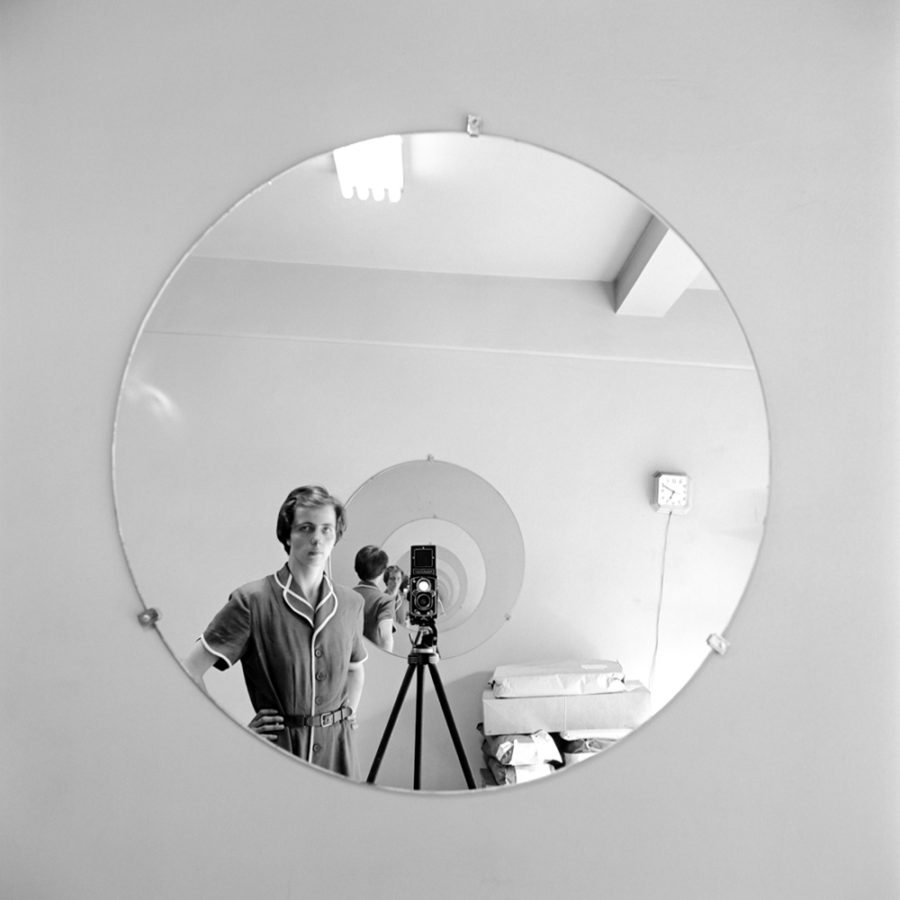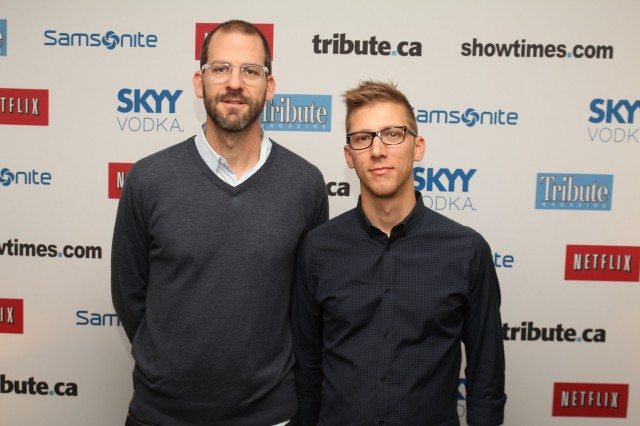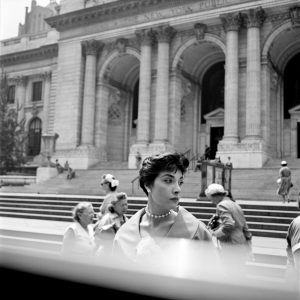
 The story of Vivian Maier is a perfect reminder of the adage that says that “truth is stranger than fiction”. By the time of her death in 2009, the lanky French-American nanny seemed to have left nothing behind but a storage room full of useless artifacts and boxes full of junk. Enter neophyte historian and real estate agent John Maloof, who two years earlier had bought a box containing over 30,000 negatives of Maier’s unpublished work and unfortunately found her a few days after she had passed away. Upon realizing the brilliance of her oeuvre, Maloof became obsessed with Maier and ended up obtaining over 100,000 negatives and starting a collection meant to preserve, curate and exhibit her work.
The story of Vivian Maier is a perfect reminder of the adage that says that “truth is stranger than fiction”. By the time of her death in 2009, the lanky French-American nanny seemed to have left nothing behind but a storage room full of useless artifacts and boxes full of junk. Enter neophyte historian and real estate agent John Maloof, who two years earlier had bought a box containing over 30,000 negatives of Maier’s unpublished work and unfortunately found her a few days after she had passed away. Upon realizing the brilliance of her oeuvre, Maloof became obsessed with Maier and ended up obtaining over 100,000 negatives and starting a collection meant to preserve, curate and exhibit her work.
Maier’s photographs offer a peek into the lives of Americans between the 1950s and the 1970s. She shot her unaware subjects with affection and curiosity, her pictures always containing a picaresque, playful element. Her work shows her to have been a woman who was endlessly fascinated by human behavior and the world around her, making the size of her work all the more perplexing because before Maloof found it, no one else had laid eyes on it.
The mysterious Maier is the subject of “Finding Vivian Maier”, a nonfiction film co-directed by Maloof and Charlie Siskel (read our review here). Since its debut at the 2013 Toronto Film Festival, the film has won accolades in film festivals all over the world and even earned a place among the Panorama Dokument series at the 2014 Berlinale. On the eve of its theatrical release in the US, we sat down with Maloof and Siskel who talked about the inspiration behind the film’s tone, their lives after making the movie and Vivian’s dark side.
SB: What have you been up to since wrapping up on the film?
JM: A lot of press, a lot of people talking about it, the film comes out on the 28th, so we’ve been traveling to festivals.
SB: I was just curious because recently we’ve seen documentaries that change or are updated after their festival debut and before being released in theaters…
JM: No, the film was completely edited and finished.
SB: I thought it was very interesting how you bought the negatives because you were working on a history book. So I wondered how did you become a historian in the first place?
JM: I moved into a neighborhood and bought a property that was 100 years old and doing some renovations I got a new appreciation for the building and the neighborhood. I thought it would be interesting to make a small history book.
SB: I read that after finding the negatives you enrolled in a photography class in order to learn how to develop films. So based on this and your previous career as a historian in your neighborhood, you seem to have a personality where you become obsessed with learning new things. Were you always like this?
JM: (laughs) Probably...I guess what it comes down to is when I become obsessed with something my life revolves around it and I live it. So with photography I was obsessed with it when I started. My attic was a dark room, my basement where I developed my negatives, and I was waking up at the crack of dawn and going downtown in the winter taking street photos, learning how to do this.

SB: So how did you decide you wanted to turn Vivian’s story into a film as opposed to just a blog post and also, did you enroll in film courses to learn how to make films as well?
JM: It was late 2009 and I found the family that she worked for through a lead in one of her things, I called them and they told me all these fascinating things about her; that she was a nanny and that they were extremely close to her but that they didn’t know anything about her past or where she was from. So I thought this might make a great documentary. So then, long story short, Jeff Garland came on board after we had some press on the story, he was interested and offered to be a producer, I told him “I need some help, I’ve never made a feature documentary before”. I was teaching myself as much as I could but I needed someone to help me because I needed hands on help. Charlie came on to the project through Jeff, and Charlie was basically giving me a handful of films a week to watch, and we talked about what we liked and wanted to use in our film. He was my mentor and gave me a crash course on filmmaking for over a year.
CS: John is a quick study and he had basically taught himself, both still photography and cinematography for the film, and as far as figuring out how to tell the story I had some instincts about that and the real challenge was how to tell Vivian’s story and along with that we were telling John’s story because he is the person who discovered her work and pursued it with incredible tenacity. We needed to weave those stories together and in a way they were linked because if John hadn’t found her pictures and curated them, Vivian would be unknown. It became a detective story, how do we reveal as much as we can about this mystery which at its center posed the question: why did she take all these pictures and never shared them with the world? So that went from being a why, to a how, because the people who knew her, knew her only as a nanny, so we had to tell the story of an incredible artist who masqueraded as a nanny and had to juggle these parts of her life. The how of her life is more interesting than the why, because she did this tremendous work without the validation of critics, other photographers or galleries, so the parallels between her and John are very striking…
SB: In the film you show that Vivian had a very dark side as well and in this time and age when people judge artists based on their personal lives. How much did you tone down the darkness and try to turn her into a hero or a lovable underdog?
JM: We did not. Charlie said “I don’t want to sugarcoat anything” and I agreed, so when we found things that were dark we included them. We didn’t hide anything. Basically there was nothing else, as far as abuse stories from other people.
CS: At the same time we didn’t want to give this more weight than it deserved. We would hate for people to come away from the film thinking that this is the dominant part of the story. For us it was a small part of Vivian’s story, we understand that it will color some people’s sense of who she was - and it should - but with that said we feel people should judge for themselves what significance this should have. Our overall impression is that Vivian was a brilliant artist, but she was also funny and charming, and even though she had some oddity to her, she wasn’t some weird recluse. She was opinionated, chatty, she told people what she thought. People remembered her fondly even if they had memories of some of her darkness. She was interested in crime, but I don’t know if this was necessarily a morbid curiosity, but more of a realistic, unflinching view of humanity. I don’t think she meant to be gratuitous or shocking, she was interested in showing humanity even when we were not at our best.

SB: Since you mentioned you wanted to highlight the parallels between Vivian and John, I have to confess I couldn’t help but feel like it was a very charming love story…like that Christopher Reeve/Jane Seymour movie, so I was wondering if there was anything behind this concept of “soulmates divided by time” sort of thing?
JM: That’s weird…(laughs) I mean I have an emotional attachment to her work. Vivian changed my life. I’m a filmmaker and a photographer and it’s all because of my discovery of her. Of course there’s some connection I can’t really describe. I feel I owe her the best respect I can give her.
JM: We have been approached by Christine Vachon of Killer Films but everything is still in the works, nothing has been released as of yet…
SB: And you’ve also said that you mostly want her work to speak for itself, so how easy was it to choose what to include in the film?
JM: Obviously the work we picked was the one that illustrates the story. We had a great body of really strong work that we were wondering where to use. For example in the end, we used a lot of similar subjects that she captured to illustrate what was going on in her life. To express that she was now living out the fate of the subjects she’d photographed when she was younger. We thought there was a connection there.
SB: With the movie opening Friday, who would you say is the right audience for your film?
JM: Everybody!
CS: We wanted to make a film that was entertaining. This is a great story, anyone who hears the headline of what the story is, they feel compelled to know more. I certainly did. The more you learn, the more you want to dig. We wanted to make not an art film but an entertaining film, the kind we’d all want to see. Vivian’s work needs to be presented in a respectful, beautiful way and we think we did that. Seeing her photographs on the big screen is incredible and breathtaking, but the story is also funny and it has elements of a detective story. It takes the audience on a fun ride.
“Finding Vivian Maier” opens at Lincoln Plaza Cinema and the IFC Center on March, 28, 2014.